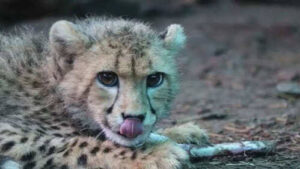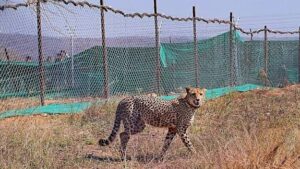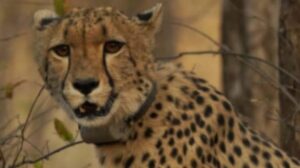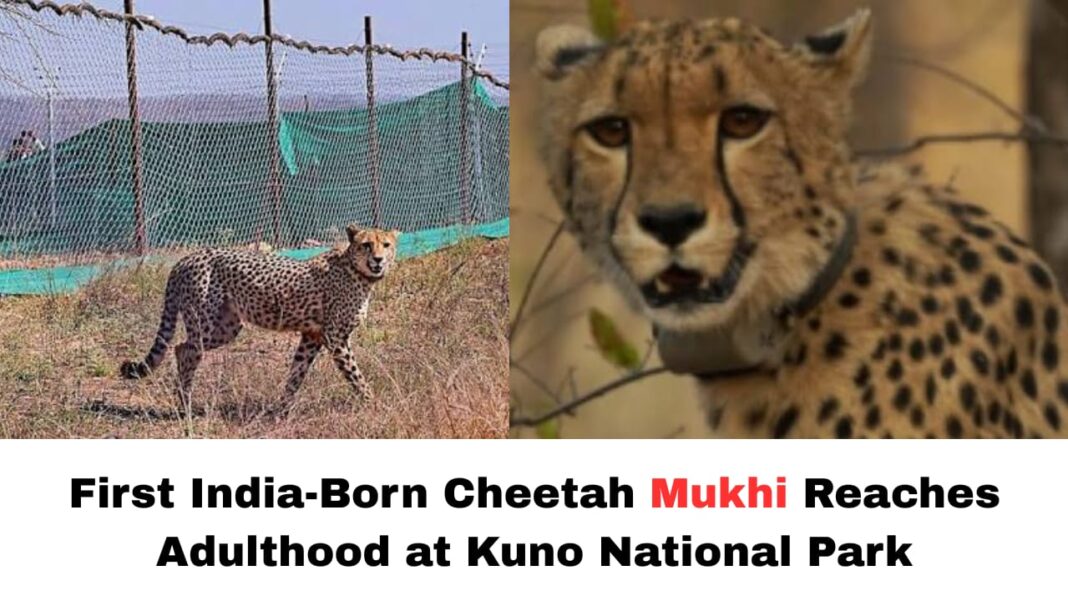Digital News Guru Madhya Pradesh Desk:
Mukhi’s Milestone: India-Born Cheetah Reaches Adulthood, Symbolizing Hope for Wildlife Restoration
In a significant milestone for India’s wildlife conservation efforts, Mukhi, a cheetah born at Kuno National Park in Madhya Pradesh, has officially reached adulthood. This marks the first time in India that a cheetah born as part of the country’s reintroduction programme has survived past the vulnerable juvenile stage into maturity. It’s not just a moment to celebrate, but a validation of the many efforts, challenges, and hopes invested in bringing back a species that had disappeared from Indian landscapes for over seven decades.
From Fragile Beginnings to Maturity
Mukhi’s journey has been one of survival against odds. Born on March 29, 2023, Mukhi is the offspring of Jwala (also known by her Namibian name, Siyaya), one of the cheetahs translocated from Namibia in 2022 under Project Cheetah. The litter had four cubs, but only Mukhi survived. Her siblings succumbed to the extreme heat and dehydration during a heatwave, underscoring the delicate nature of reintroduction in unfamiliar or extreme climates.

Early life for Mukhi included being abandoned by her mother, Jwala, after reintroduction attempts failed. She had to be hand-reared by the wildlife veterinary team at Kuno. This involved continuous care, medical attention, monitoring, careful feeding, and protection from environmental stress.
Mukhi turned two recently, celebrated by the Park (including a video release and photos) as she stepped into adulthood. This period has been marked by her adapting to the habitat, observing wild behaviors, and learning (through observation and by support staff) skills needed for a cheetah in the wild.
Why Adulthood Matters: Ecological & Conservation Significance
Mukhi’s survival to adulthood is more than a personal triumph—it is a signal that India’s ambitious conservation goal of establishing a self-sustaining cheetah population may be within reach. Mukhi is the first of the India-born cheetahs under Project Cheetah to cross this threshold.
Here’s what her maturity symbolizes:
- Proof of concept: The reintroduction programme, which began in earnest in 2022, has had multiple challenges—high heat, environmental stress, health issues, adaptation to habitat, mortality of many cubs. Mukhi’s survival suggests that strategies for health care, habitat management, and intervention are working.
- Boost to stakeholder confidence: For forest officials, wildlife veterinarians, conservation NGOs, and the general public, Mukhi provides a visible, living landmark of success. Her growth encourages further investment, both financial and institutional, in these programmes.
- Genetic continuity & possibility of breeding: While Mukhi herself may or may not reproduce, her survival increases the chances that more cubs will make it past infancy. Over time, this is crucial for achieving sufficient population numbers and genetic diversity.
- Highlighting adaptation and local ecological fit: India’s climate, prey base, terrain, and threats differ greatly from African habitats. Mukhi’s ability to survive, adapt, and grow in Kuno suggests that mixed interventions—such as veterinary care during early life, habitat preparation, and managed exposure—are required and are working.

Remaining Challenges & What Mukhi’s Example Doesn’t Solve
Mukhi is a hopeful sign, but she doesn’t resolve all the hurdles faced by Project Cheetah and similar conservation efforts. Some of the challenges include:
- Mortality risks in early life: Mukhi’s siblings died due to heat and dehydration. Extreme climatic events, especially heatwaves, pose serious threats in Kuno and other Indian wildlife reserves. Prevention requires infrastructure, rapid veterinary assistance, and protocols adapted to Indian seasons.
- Habitat and prey constraints: For a cheetah population to thrive, adequate prey species, sufficient space, and minimal threats from predators like leopards, or from human-wildlife conflict, are essential. While Kuno has been chosen for its suitability, balancing all ecological factors over time is complex.
- Genetic diversity & long-term viability: Starting populations are small. Ensuring that cheetahs do not become genetically bottlenecked, and that there is healthy reproduction over generations, will require careful planning.
- Resource demands: Hand-rearing, veterinary care, monitoring, infrastructure (for shade, water, temperature regulation), and logistic support are expensive and labor intensive. These must be sustained.
- Public perception & scientific scrutiny: Project Cheetah has had its share of critics, who raise questions about ecological fit, habitat size, ethics, cost, and priority among conservation issues. Mukhi’s success helps, but rigorous transparency and adaptive management will be needed to maintain trust.
Broader Implications & Next Steps
Mukhi’s adulthood is an inflection point. It suggests several actionable focus areas for those involved in cheetah reintroduction:
- Expand breeding success and monitoring: More cubs must survive, more females reach maturity, and more births must occur in wild-adapted conditions.
- Strengthen habitat management: Ensuring prey base, mitigating conflicts, maintaining corridors, shading, water, and relief from heat will be increasingly important, particularly during summer or heatwave seasons.

- Improve environmental and veterinary interventions: Lessons learned from Mukhi and her cohort—like handling heat stress, preventing infections, monitoring for injury or disease—should be codified and refined.
- Scale up rewilding to new sites: While Kuno is core, for long-term resilience, cheetahs need multiple viable habitats. Expanding to other sanctuaries like Gandhi Sagar Wildlife Sanctuary has already been proposed and partially implemented, with relocations and releases. This helps avoid putting all eggs in one location.
- Engage communities and governance: Local communities near habitats must see benefits, protections, and involvement. Governance mechanisms must ensure accountability, transparency, and science-based decision making.
Conclusion
Mukhi’s coming of age is more than a touching story—it is a beacon for India’s conservation aspirations. She is living testimony that, with care, patience, and correct practices, it is possible to bring back a species that was declared lost in India in the mid-20th century. But the path ahead remains steep. Survival to adulthood is one milestone; sustaining a wild, self-renewing population across multiple habitats, with ecological balance, genetic health, and social acceptance, is the ultimate goal.
For Mukhi, her future now lies in fully becoming part of India’s restored wild—the cheetah that not only thrives but breeds, teaches, prowls, and helps mend ecosystems once emptied of her kind. Her story reminds us that conservation is challenging but not impossible, and that each life saved matters enormously.
You May Also Read: Tragedy in Karur: 39 Killed, Many Injured in Stampede at Vijay’s Rally








